Articles
- Page Path
- HOME > J Korean Acad Nurs > Volume 46(1); 2016 > Article
-
Original Article
- Development of Patient Transfer Techniques based on Postural-stability Principles for the Care Helpers in Nursing Homes and Evaluation of Effectiveness
- Ryewon Ma, Dukyoo Jung
-
Journal of Korean Academy of Nursing 2016;46(1):39-49.
DOI: https://doi.org/10.4040/jkan.2016.46.1.39
Published online: February 29, 2016
1Division of Nursing Science, College of Health Sciences, Ewha Womans University, Seoul·Department of Nursing, Kyungnam University, Changwon, Korea.
2Division of Nursing Science, College of Health Sciences, Ewha Womans University, Seoul, Korea.
- Address reprint requests to: Jung, Dukyoo. Division of Nursing Science, College of Health Sciences, Ewha Womans University, 52 Ewhayeodae-gil, Seodaemun-gu, Seoul 03760, Korea. Tel: +82-2-3277-6693, Fax: +82-2-3277-2850, dyjung@ewha.ac.kr
© 2016 Korean Society of Nursing Science
This is an Open Access article distributed under the terms of the Creative Commons Attribution NoDerivs License. (http://creativecommons.org/licenses/by-nd/4.0/) If the original work is properly cited and retained without any modification or reproduction, it can be used and re-distributed in any format and medium.
- 569 Views
- 4 Download
- 3 Crossref
Abstract
-
Purpose
- This study was done to develop a postural-stability patient transfer technique for care helpers in nursing homes and to evaluate its effectiveness.
-
Methods
- Four types of patient transfer techniques (Lifting towards the head board of the bed, turning to the lateral position, sitting upright on the bed, transferring from wheel chair to bed) were practiced in accordance with the following three methods; Care helpers habitually used transfer methods (Method 1), patient transfer methods according to care helper standard textbooks (Method 2), and a method developed by the author ensuring postural-stability (Method 3). The care helpers' muscle activity and four joint angles were measured. The collected data were analyzed using the program SPSS Statistic 21.0. To differentiate the muscle activity and joint angle, the Friedman test was executed and the post-hoc analysis was conducted using the Wilcoxon Signed Rank test.
-
Results
- Muscle activity was significantly lower during Method 3 compared to Methods 1 and 2. In addition, the joint angle was significantly lower for the knee and shoulder joint angle while performing Method 3 compared to Methods 1 and 2.
-
Discussion
- Findings indicate that using postural-stability patient transfer techniques can contribute to the prevention of musculoskeletal disease which care helpers suffer from due to physically demanding patient care in nursing homes.
This is manuscript is based on a part of the first author's doctoral dissertation from Ewha Womans University.
The authors declared no conflict of interest.
- 1. Park MS. Educational needs in the provision of oral care by nursing staff in long-term care facility for elderly people. J Korean Gerontol Nurs. 2010;12(1):72–80.
- 2. Ministry of Health & Welfare. Standard textbooks of care helper. Seoul: Author; 2009.
- 3. Hwang B, Youn KH, Lee JY, Kang JH, Yoo EK. An exploratory study on self-perceived symptoms and pain-inducing factors of musculoskeletal diseases among care workers in residential settings: Focused on the scope of care work and care recipients' characteristics. Soc Sci Res Rev. 2014;30(1):69–100.
- 4. Park KH, Jeong BY. Characteristics and causes of musculoskeletal disorders for employees aged 50 years or older. J Ergon Soc Korea. 2009;28(4):139–145. Article
- 5. Hwang EH, Jung DY, Kim MJ, Kim KH, Shin SJ. Comparison of frequency and difficulty of care helper jobs in long term care facilities and client homes. J Korean Public Health Nurs. 2012;26(1):101–112. Article
- 6. Lee SY, Lee YK, Joo YS, Kim MH, Choi KS. Report No.: 2011-Researcher-1356. Development of manual and survey for musculoskeletal disorders prevention of care givers. Incheon: Korea Occupational Safety and Health Agency; 2011.
- 7. Karahan A, Kav S, Abbasoglu A, Dogan N. Low back pain: Prevalence and associated risk factors among hospital staff. J Adv Nurs. 2009;65(3):516–524. ArticlePubMed
- 8. Rahmah MA, Rozy J, Halim I, Jamsiah M, Shamsul AS. Prevalence of back pain among nurses working in government health clinics and hospital in Port Dickson, Malaysia. J Community Health. 2008;14(2):11–18.
- 9. Ribeiro SB, Cárdia MC, Almeida LC. Biomechanical and organizational risk and prevalence of low back pain in the old adults caregivers of a nursing home in Joao Pessoa/PB. Work. 2012;41:Suppl 1. 1933–1939. ArticlePubMed
- 10. Bang SJ. Care is skill. Seoul: DSPub; 2011.
- 11. Hitoshi O, Haruki M. Kim YJ . Ultimate practical care. Seoul: Green Home; 2008.
- 12. Hiroshi O. Nursing field of low back pain zero manual. Tokyo, JP: Kirara Shobo; 2005.
- 13. Yukihiro A. Aoyama type patient transfer technique. Tokyo, JP: MC Media; 2012.
- 14. Shumway-Cook A, Woollacott MH. Motor control: Translating research into clinical practice. 3rd ed. Philadelphia, PA: Lippincott Williams and Wilkins; 2006.
- 15. Lee BH, Kim SY, Lee JS. The effects of core stability on postural control, balance and upper motor function in patients with stroke. J Orient Rehabil Med. 2009;19(3):69–80.
- 16. Park JK, Kim DS, Seo KB. Musculoskeletal disorder symptom features and control strategies in hospital workers. J Ergon Soc Korea. 2008;27(3):81–92. Article
- 17. Hur JG, Park CU, Lee JS. Difference of lumbar & lower extremity muscle activity when patients are transferred by physical therapists. J Ergon Soc Korea. 2011;30(5):613–619.
- 18. Szeto GPY, Wong KT, Law KY, Lee EWC. A study of spinal kinematics in community nurses performing nursing tasks. Int J Ind Ergon. 2013;43(3):203–209. Article
- 19. Kee D. Workload of patients transferring and its improving methods. J Korean Soc Saf. 2006;21(2):121–127.
- 20. Jeong BY. Ergonomics' role for preventing musculoskeletal disorders. J Ergon Soc Korea. 2010;29(4):393–404. Article
- 21. Faul F, Erdfelder E, Lang AG, Buchner A. G*Power 3: A flexible statistical power analysis program for the social, behavioral, and biomedical sciences. Behav Res Methods. 2007;39(2):175–191. ArticlePubMedPDF
- 22. Kim TW, Kong SJ, Kil SK, Park JC, Jeon HJ, Song JH, et al. Electromyographic analysis: Theory and application. Seoul: Hanmi Medical Publishing Co.; 2013.
- 23. Lee HJ. The effects of tuina program on nurses with low back pain [dissertation]. Seoul, Hanyang University. 2002.
- 24. Yu N. The differences about nursing practice activity, working environment, body mechanics, job stress and job satisfaction between low back pain group and no low back pain group in ICU nurses [master's thesis]. Seoul, Ewha Womans University. 2006.
- 25. Kim CH, Kwon JK, Moon MK, Lee MH, Lee JS. A study for the effects of lifting position, age and gender on maximum lifting strength. In: Fall Conference and General Meeting Ergonomics Society of Korea; 2011 October 21-22; Cheonan's Sangnok Resort. Cheonan, Eromonomics Society of Korea; 2011. p. 148–153.
- 26. Callison MC, Nussbaum MA. Identification of physically demanding patient-handling tasks in an acute care hospital. Int J Ind Ergon. 2012;42(3):261–267. Article
- 27. Kim DD, Kim YH, Lee GC, Jung BO, Cho NJ, Kwon WA, et al. Kinesiology. Seoul: Hyunmoonsa; 2013.
- 28. Kim SU, Han SJ. Effects of load center of gravity and feet positions on peak EMG amplitude at low back muscles while lifting heavy materials. J Korean Soc Occup Environ Hyg. 2012;22(3):256–263.
- 29. Choi J, Kim HS, Kim GS, Lee H, Jeon HS, Chung KM. Posture management program based on theory of planned behavior for adolescents with mild idiopathic scoliosis. Asian Nurs Res. 2013;7(3):120–127. Article
- 30. Park JS, Kim JY. Workload evaluation of various shoulder posture by using muscle force, fatigue and psychophysical workload. J Ergon Soc Korea. 2012;31(2):281–289. Article
REFERENCES
Figure & Data
REFERENCES
Citations

- Low Back Pain and Its Influencing Factors among Intensive Care Unit Nurses: A Cross-sectional Study
Hyun Ju Uhm, Hye-Ja Park
Journal of Health Informatics and Statistics.2022; 47(2): 95. CrossRef - Effects of a Lumbar Stabilization Exercise Program on Low Back Pain, the Oswestry Disability Index, Use of Body Mechanics, and Lumbar Strength among Intensive Care Unit Nurses
Hae Mi Jang, Hye-Ja Park
Journal of Health Informatics and Statistics.2022; 47(3): 209. CrossRef - Design and Control of Upper-Body Assistive Wearable Robot Using Pneumatic Artificial Muscles
Hyun-Suh Choi, Hyun-Ji Lee, Tae-Jin Ahn, Hyun-Ki Jung, Jung-Yup Kim
Journal of the Korean Society of Manufacturing Technology Engineers.2018; 27(3): 235. CrossRef
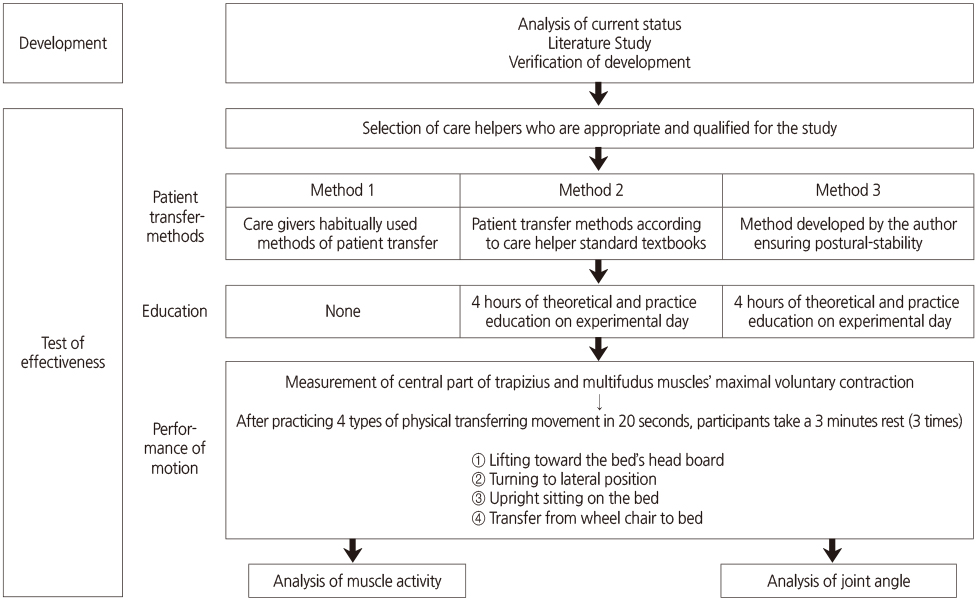
Figure 1
Postural-stability Patient Transfer Technique
General Characteristics of Care Givers (N=20)
A Description of Each Variable (N=20)
*p<.05; Method 1=Care giver habitually used methods of patient transfer; Method 2=Patient transfer methods according to care helper standard textbooks; Method 3=Method developed by the author ensuring postural-stability.
Description of Each Variable (N=20)
*p<.05; Method 1=Care giver habitually used methods of patient transfer; Method 2=Patient transfer methods according to care helper standard textbooks; Method 3=Method developed by the author ensuring postural-stability.
*
*
 KSNS
KSNS
 E-SUBMISSION
E-SUBMISSION

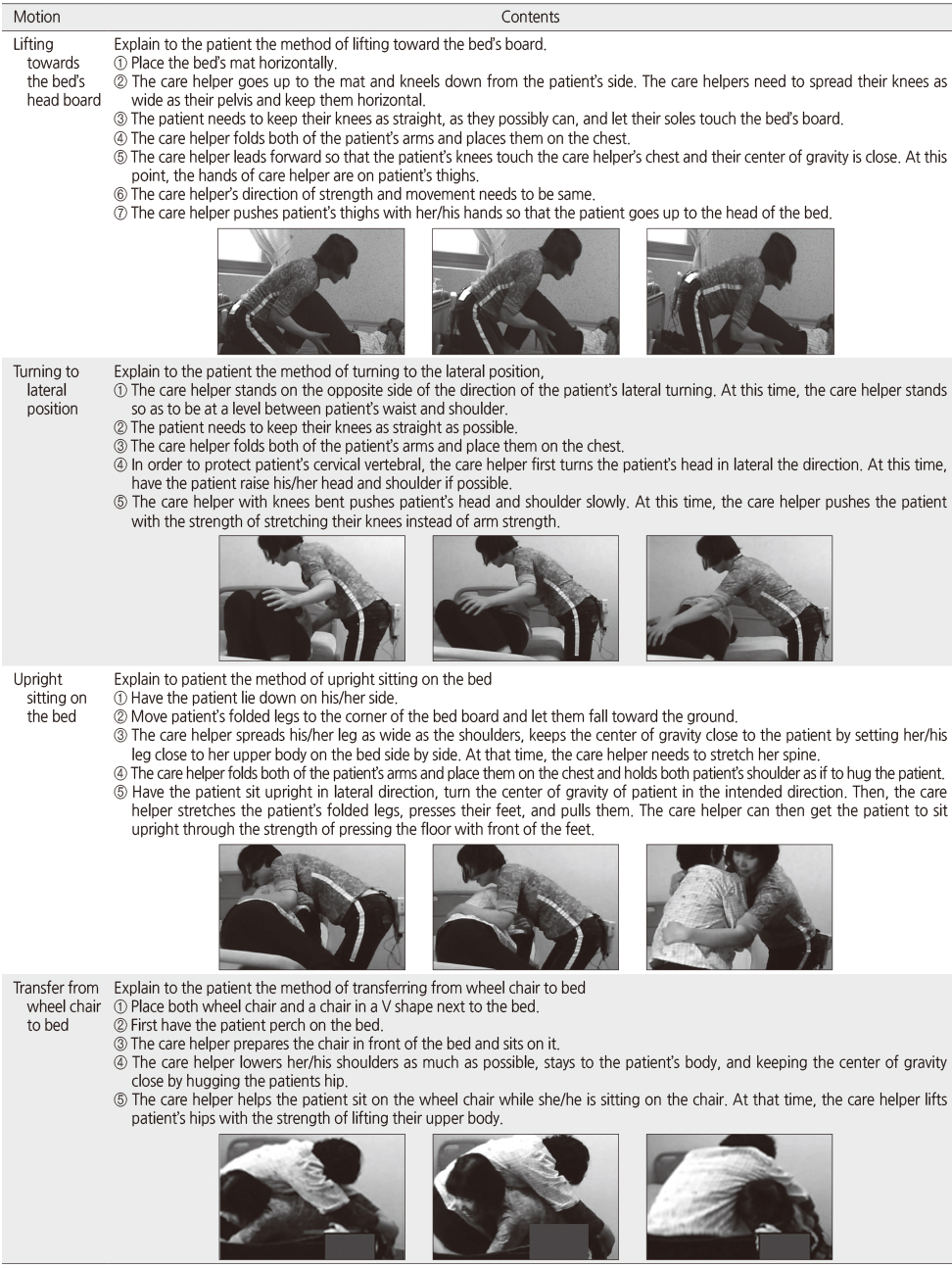
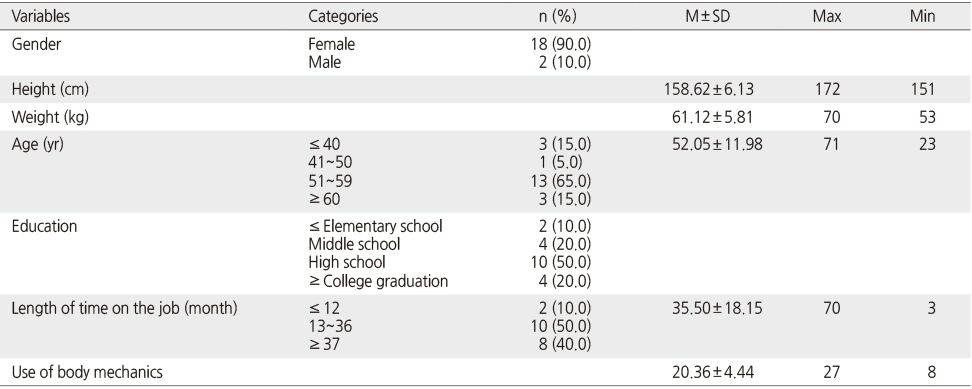
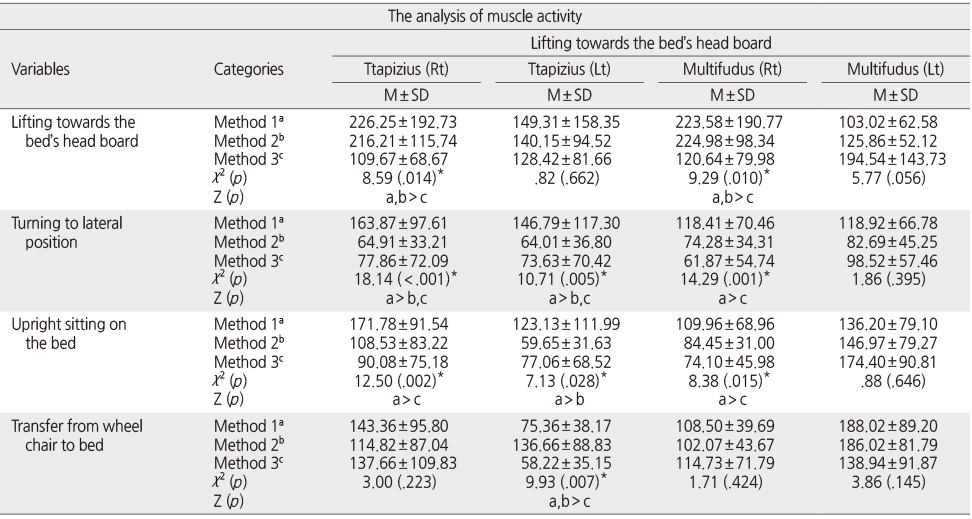
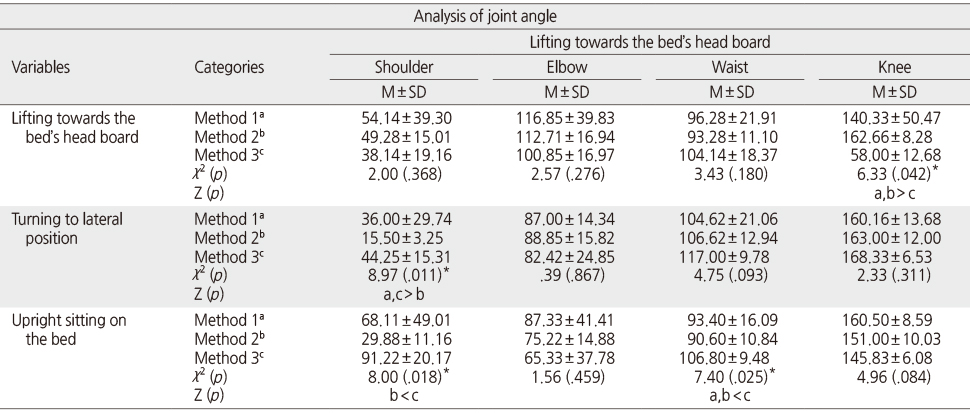
 Cite
Cite

